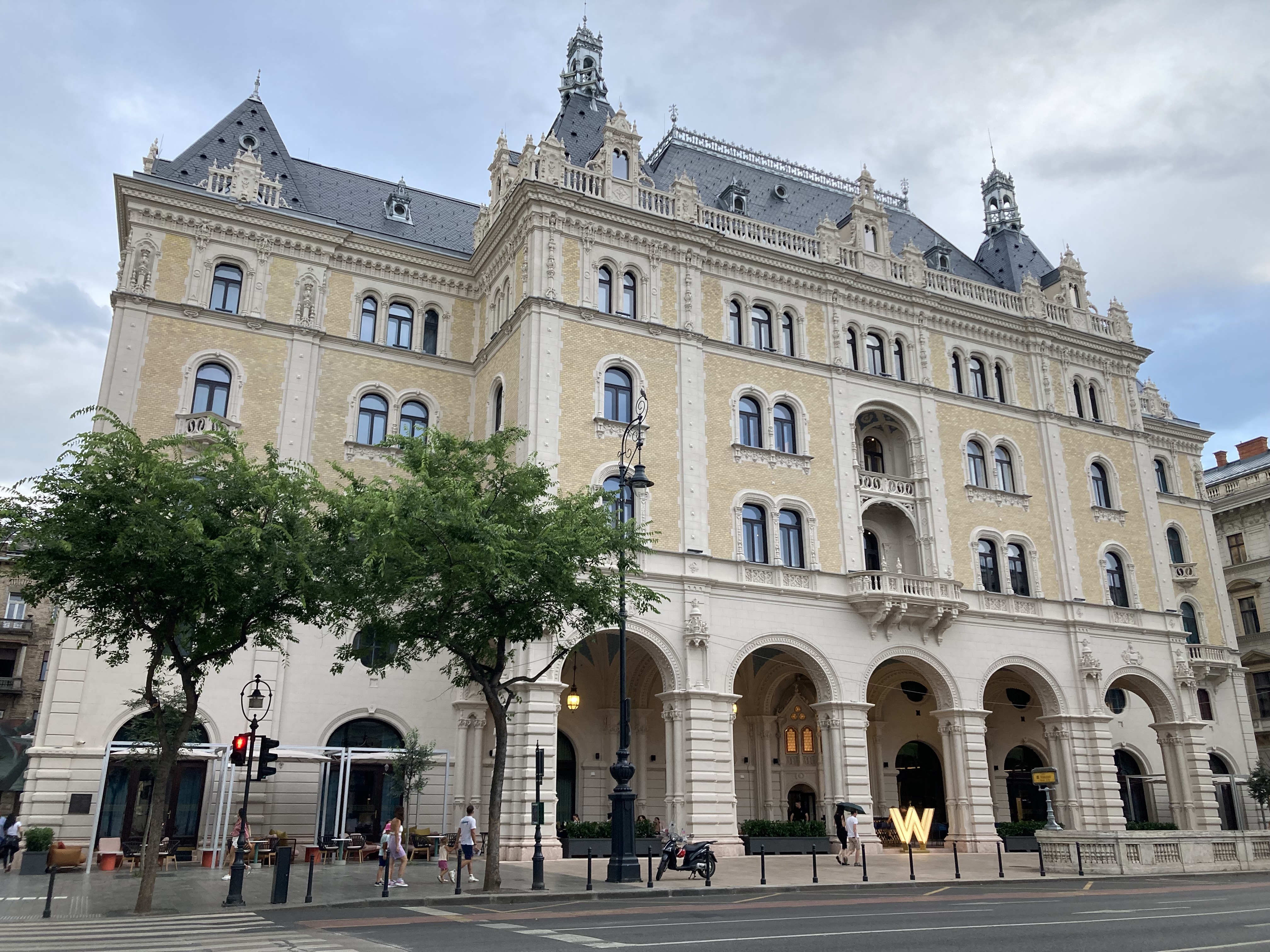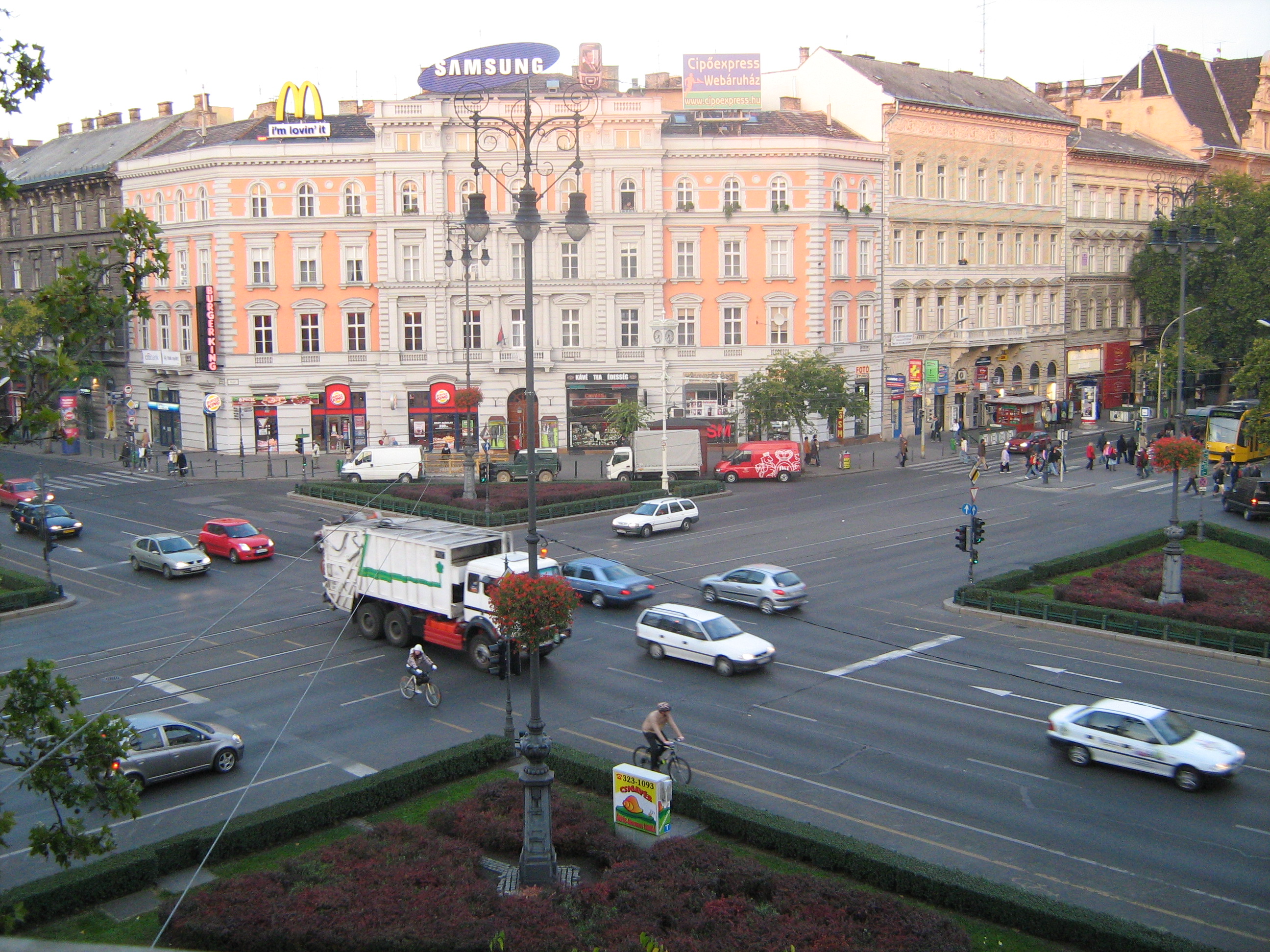Photo by: Davidi Vardi, CC BY-SA 4.0
At the base of Andrássy Avenue Budapest – Panoramic view of Heroes’ Square in Budapest with the Millennium Monument and statues of Hungarian leaders under a blue sky.
Unlocking Andrássy Avenue Budapest: 12 + Hidden Secrets of District VI
Andrássy Avenue Budapest is in District VI, known as Terézváros. It is one of Budapest’s most culturally rich and architecturally stunning areas. Home to the grand Andrássy Avenue – a magnificent UNESCO World Heritage Site that serves as the heart of Budapest – this district features world-renowned theaters and historic cafés. Terézváros offers a perfect blend of old-world elegance and modern vibrancy, connecting the bustling city centre with the tranquil City Park. Whether you’re an art lover, a history enthusiast, or simply someone who enjoys a leisurely stroll through beautiful streets lined with elegant palace buildings and historic villas, Terézváros has something to captivate you. Join us on a walking tour through this district, where every step reveals a new facet of Budapest’s cultural heart, from Buda’s historic charm to Pest’s vibrant energy.
1. Start at Heroes’ Square (Hősök tere)
Why Start Here: Begin your journey at Heroes’ Square, one of the most iconic and grandiose squares in Budapest. Located at the end of Andrássy Avenue where the avenue ends at the entrance to City Park (Városliget), this square is a fitting starting point for your exploration of Terézváros, symbolizing the city’s rich history and national pride. The square was completed in 1896 to commemorate Hungary’s millennium celebrations.
What to See:
Millennium Monument: Admire the imposing Millennium Monument, featuring statues of Hungary’s historical leaders and the seven chieftains who founded the nation. The monument commemorates the 1,000th anniversary of the Hungarian conquest of the Carpathian Basin, when Hungary celebrated its foundational moment in 1896.
Museum of Fine Arts and Műcsarnok: On either side of the square, you’ll find the Museum of Fine Arts, housing a vast collection of European art, and Műcsarnok (Hall of Art), which showcases contemporary art exhibitions. The area also connects to the University of Fine Arts, making this cultural quarter particularly significant. Consider visiting one or both museums to start your day with a cultural experience.
2. Walk Down Andrássy Avenue
Budapest’s Champs-Élysées: From Heroes’ Square, begin your walk down Andrássy Avenue, Budapest’s most famous boulevard and a designated UNESCO World Heritage Site. This elegant avenue in Budapest, stretching from the city center to City Park, was inaugurated in the 1880s and named after Count Gyula Andrássy, who served as Prime Minister. The avenue was designed to rival the grand boulevards of Paris, and the history of Andrássy Avenue reflects Budapest’s aspirations during the Austro-Hungarian era.
What to See:
Historic Mansions: As you stroll along Andrássy Avenue, take in the beautiful architecture of the historic mansions and palace buildings that line this grand avenue. Many of these elegant structures now house embassies, offices, and cultural institutions, showcasing the high-end character of the district.Embassy Row: Pass by Embassy Row, where you’ll find the grand embassies of various countries, each housed in a stately palace that reflects the diplomatic importance of the area and the avenue’s prestigious status.
Underground Railway: Beneath your feet runs the historic underground railway, one of Europe’s first subway systems, completed in 1896. This metro line connects Andrássy Avenue to other parts of the city, including the connection between Budapest and Vienna’s railway networks.
Boutiques and Cafés: Andrássy Avenue is also home to some of Budapest’s most luxurious boutiques, including high-end stores like Louis Vuitton, and charming cafés. If you’re in the mood for a coffee or a pastry, stop by one of the elegant cafés for a quick refreshment.
Hidden Courtyards of Kodály körönd: While the façades of Andrássy Avenue shine with neo-Renaissance elegance, some interiors tell a more complex story. At Hübner Court (Andrássy út 94), for example, fading plaster, mosaic floors, and wrought-iron staircases reveal the grandeur of the past alongside the wear of time. These hidden courtyards remind visitors that Andrássy Avenue is not just a polished boulevard but also a living piece of history where beauty and decay coexist.
3. Visit the House of Terror Museum
A Sobering Historical Experience: Midway along Andrássy Avenue, you’ll come across the House of Terror Museum, a powerful and thought-provoking museum dedicated to the victims of the fascist and communist regimes in Hungary. The building itself was once the headquarters of both the Nazi and communist secret police, during a dark period when parts of the avenue were even named after Hitler and Mussolini.
What to Explore:
Museum Exhibits: Inside, the museum’s exhibits detail the horrors of the regimes that once ruled Hungary, focusing on the persecution, torture, and executions that took place in this very building. It’s a somber but important visit that offers deep insights into Hungary’s 20th-century history, particularly the period from 1872 through the communist era.
Memorial Wall: Outside the museum, the Memorial Wall honors those who lost their lives during these dark periods. Take a moment to reflect before continuing your walk along the avenue.
4. Stop by the Hungarian State Opera House
A Cultural Icon: Further down Andrássy Avenue, you’ll find the Hungarian State Opera House, one of Budapest’s most beautiful and acoustically renowned buildings. Designed by Miklós Ybl and completed in 1884, this neo-Renaissance palace masterpiece is a must-see for anyone interested in architecture and the performing arts, including the Hungarian State Opera’s world-class performances.
What to See:
Exterior and Interior: Admire the ornate façade of the Opera House, with its grand arches, statues, and intricate detailing that exemplifies the buildings along Andrássy Avenue’s architectural grandeur. If possible, step inside to see the equally stunning interior, featuring marble staircases, gilded decorations, and lavish frescoes.
Ballet Institute: The building also houses the renowned Ballet Institute, continuing its tradition as a center for performing arts education.Attend a Performance: If time allows and you’re a fan of classical music or opera, consider attending a performance. The experience of watching a show in such a historic and opulent setting is truly unforgettable, showcasing why this venue remains at the heart of Budapest’s cultural scene.
5. Visit the Ernst Museum
Just a short walk down Andrássy Avenue from the Opera House, the Ernst Museum adds another cultural layer to the boulevard. Founded in 1912 by art patron Lajos Ernst, it originally showcased contemporary Hungarian art and became a hub for the city’s modern artistic movements. While its role has shifted over time, the building continues to host exhibitions and cultural events, making it a worthwhile stop for visitors interested in Budapest’s artistic heritage.
6. Explore Liszt Ferenc Square (Liszt Ferenc tér)
Café Culture and Music: Just off Andrássy Avenue via a charming side street, Liszt Ferenc tér is a lively and picturesque square named after the famous Hungarian composer Franz Liszt. This square, accessible through a side street off Andrássy, is the perfect spot to take a break and enjoy Budapest’s vibrant café culture while remaining close to the Danube’s eastern banks.
What to See:
Statue of Franz Liszt: At the center of the square, you’ll find a statue of Franz Liszt, paying tribute to the composer’s enduring legacy. The square is also home to the Liszt Academy of Music, a prestigious institution for music education that continues the musical traditions linking Budapest and Vienna.
Cafés and Restaurants: Liszt Ferenc tér is lined with outdoor cafés and restaurants, making it a popular spot for both locals and tourists. Take a seat at one of the terraces, order a coffee or a glass of wine, and soak in the atmosphere of this charming corner near the avenue.
7. Visit the Franz Liszt Academy of Music
A Musical Heritage: Adjacent to Liszt Ferenc tér, the Franz Liszt Academy of Music is a world-renowned institution that has educated many of Hungary’s greatest musicians. The building itself is an architectural gem designed by Ödön Lechner, blending Art Nouveau and historicist styles that complement the palace-like structures along the avenue.
What to Explore:
Concert Hall: If you’re a music lover, consider attending a concert at the academy’s concert hall, known for its superb acoustics and stunning interior. Even if you don’t catch a performance, the building’s lobby and exterior are worth admiring.
Music Exhibits: The academy often hosts exhibits and events related to Hungarian music history, including tributes to Zoltán Kodály and other Hungarian composers, offering further insights into the country’s rich musical traditions.
8. Discover Kodály Körönd
An Architectural Circle: As you continue along Andrássy Avenue, you’ll encounter Kodály Körönd, a beautiful circular intersection named after the composer Zoltán Kodály. This elegant roundabout, completed in 1884, showcases some of the finest villa architecture along the avenue.
What to See:
Historic Villas: The körönd is surrounded by magnificent neo-Renaissance villas and palace buildings, many designed in the 1880s. These structures represent some of the most prestigious residential architecture in the city.
Mai Manó House: Look for the Mai Manó House, a significant cultural venue that adds to the artistic character of this section of the avenue.
9. Explore Side Streets and Cultural Venues
Hidden Gems: Take time to explore the various side streets that branch off from Andrássy Avenue, including Bajza Street and other charming thoroughfares. These streets often house additional cultural venues, including the Postal Museum and other specialized institutions.
What to Discover:
Drechsler Palace: Near the Opera House, you’ll find the beautiful Drechsler Palace, another architectural gem that exemplifies the high-end character of the district.
Paris Department Store: Along the avenue, historical commercial buildings like the former Paris Department Store showcase the area’s commercial heritage dating back to the late 19th century.
10. End Your Walk at Oktogon and Nagymező Street
The Broadway of Budapest: Conclude your walk at Oktogon, a major intersection where Andrássy Avenue meets the Grand Boulevard and connects to Nagymező utca. Nagymező Street is often referred to as the “Broadway of Budapest” due to its concentration of theaters, cultural venues, and lively nightlife, making this intersection a vital part of the city centre’s entertainment district.
What to See:
Theaters and Performances: As you walk down Nagymező utca, you’ll pass several historic theaters, including the Budapest Operetta Theatre and the Thália Theatre. These venues continue the cultural legacy that makes this area so special, with performances that rival those found between Budapest and Vienna’s theater scenes.
Connection to Buda Castle: From this location, you can easily access other parts of the city, including routes toward Buda Castle across the Danube, making it an excellent hub for further exploration.
Nightlife and Dining: Nagymező utca is also known for its vibrant nightlife, with a variety of bars, clubs, and restaurants to choose from. It’s a great place to end your day with a delicious dinner or a fun night out in the heart of Budapest.
Conclusion
Your walk through District VI: Terézváros has taken you on a journey through one of Budapest’s most culturally and architecturally significant areas. From the grandeur of Heroes’ Square and the UNESCO World Heritage Site that is Andrássy Avenue to the lively atmosphere of Liszt Ferenc tér and Nagymező utca, Terézváros offers a rich tapestry of experiences. The avenue is one of Europe’s most beautiful boulevards, connecting City Park with the city center while showcasing the architectural legacy of Count Gyula Andrássy and the vision of Prime Minister Gyula Andrássy.
As you reflect on the day, you’ll appreciate the district’s blend of history, art, and modern life, from the elegant palace buildings and historic villas to the underground railway that has served the city since 1896. Whether you’re exploring the grand avenue that stretches from Pest toward the Danube or discovering the charming side streets that branch off along the avenue, Terézváros always has something new to discover. This magnificent avenue in Budapest truly represents the heart of the city’s cultural and architectural heritage, making it a must-visit destination for anyone exploring Hungary’s magnificent capital.











